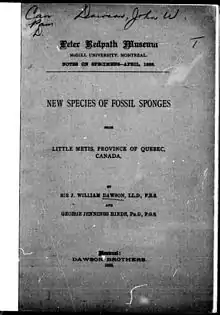George Jennings Hinde
George Jennings Hinde (né le , mort le ) est un géologue[1] et un paléontologue britannique[2].
| Naissance | |
|---|---|
| Décès |
(à 78 ans) Croydon |
| Nationalité | |
| Activités |
| Membre de | |
|---|---|
| Distinction |
Travaux
Hinde fait de nombreuses études de scolécodontes à partir d'échantillons d'Angleterre, du Pays de Galles, du Canada et de Suède[3] - [4] - [5] - [6] établissant une base pour la nomenclature de ce qu'il considère comme des éléments isolés de machoires d'annélides.
Il étudie aussi les conodontes du Canada et des États-Unis[7], ou d'Écosse[8]. Il nomme le genre Polygnathus en 1879[9]. D'autres auteurs, tels qu'Edward Branson et Maurice Mehl, continuent son travail sur les spécimens de conodontes de Hinde préservés au British Museum. C'est à partir de ces spécimens qu'ils nomment le genre Ozarkodina en 1933[10].
_BHL12327684.jpg.webp)
Il publie son Catalogue des éponges fossiles (Catalogue of the fossil sponges in the Geological Department of the British Museum (Natural History). With descriptions of new and little-known species (Illustrated by 38 lithographic plates.) en 1883[11]

En 1888, il publia avec John William Dawson New species of fossil sponges from Little Metis, province of Quebec, Canada.
Récompenses
En 1896, il devient membre de la Royal Society.
En 1897, il reçoit la médaille Lyell, une récompense prestigieuse décernée annuellement par la Société géologique de Londres (Geological Society of London).
Hommages
La médaille de Hinde est une récompense décernée par la Pander Society, une organisation informelle fondée en 1967 pour la promotion de l'étude paléontologique des conodontes.
Les genres de conodontes Hindeodella, Hindeodelloides et Hindeodus sont nommés d'après G.J. Hinde[12].
Les noms d'espèces portant l'épithète hindei, sont également un hommage à G.J. Hinde. On les trouve par exemple dans les noms d'espèces d'animaux préhistoriques suivants :
- Diagoniella hindei, une espèce d'éponges
- Choia hindei, une espèce d'éponges
- Calceolispongia hindei, une espèce de crinoïdes
Références
- (en) M. O'Connell, « George Jennings Hinde », Science, vol. 48, no 1250, , p. 588–90 (PMID 17738453, DOI 10.1126/science.48.1250.588, Bibcode 1918Sci....48..588O, lire en ligne).
- (en) « Fossil Sponge-Spicules from the Upper Chalk, found in the Interior of a Single Flintstone from Horstead Norfolk. By George Jennings Hinde, F.G.S. With five Plates. 8vo. Munich, 1880 », Annals and Magazine of Natural History, vol. 7, no 39, , p. 268–269 (DOI 10.1080/00222938109459506).
- (en) Hinde G. J., 1879. On annelid jaws from the Cambro-Silurian, Silurian and Devonian Formations in Canada and from the Lower Carboniferous in Scotland. Quarterly Journal of the Geological Society of London, 35, 370-389.
- (en) Hinde G. J., 1880. On annelid jaws from the Wenlock and Ludlow Formations of the west of England. Quarterly Journal of the Geological Society of London, 36, 368-378.
- (en) Hinde G. J., 1882. On annelid remains from the Silurian strata of the Isle of Gotland. Birand till Kungliga Svensk Vetenskapsakademiens, Hindlingas, 7, 3-28.
- (en) Hinde G. J., 1896. On the jaw-apparatus of an annelid (Eunicites reidiae sp. nov.) from the Lower Carboniferous of Halkin Mountain, Flintshire. Quarterly Journal of the Geological Society of London, 52, 438-450.
- (en) Hinde G. J., 1879. On Conodonts from the Chazy and Cincinnati Group of the Cambro-Silurian, and from the Hamilton and Genesee-Shale Divisions of the Devonian, in Canada and the United States. Quarterly Journal of the Geological Society of London, v. 35, part 3, no. 139, p. 351-369, pls. XV– XVII (with discussion on p. 389), DOI 10.1144/GSL.JGS.1879.035.01-04.23.
- (en) Hinde G.J., 1900. Notes and descriptions of new species of Scotch Carboniferous conodonts. Transactions of the Natural History Society of Glasgow.
- (en) Philip G. M. & Jackson J. H., 1967. Lower Devonian Subspecies of the Conodont Polygnathus linguiformis Hinde from Southeastern Australia. Journal of Paleontology, Vol. 41, No. 5 (Sep., 1967), pages 1262-1266 (URL stable sur JSTOR, site consulté le 1er mai 2016).
- (en) Branson E.B. & Mehl M.G., 1933. A study of Hinde's types of conodonts preserved in the British Museum, University of Missouri Studies, 8:133–156, pages 165–167.
- (en) George Jennings Hinde, Catalogue of the fossil sponges in the Geological Department of the British Museum (Natural History). With descriptions of new and little-known species. (Illustrated by 38 lithographic plates.) by George Jennings Hinde, (DOI 10.5962/bhl.title.12006, lire en ligne).
- (en) Pander Society Newsletter #39, juillet 2007 (site consulté le 1ert mai 2016)
Liens externes
- (en) Obituary—George Jennings Hinde par Henry Woodward - 1918 (site consulté le 1er mai 2016)
- Ressources relatives à la recherche :
- Notice dans un dictionnaire ou une encyclopédie généraliste :